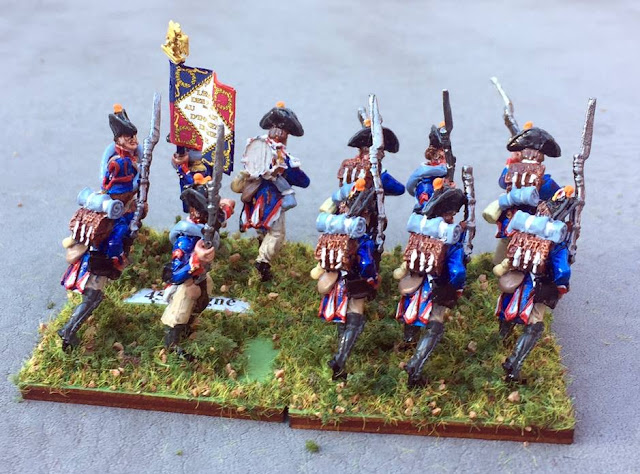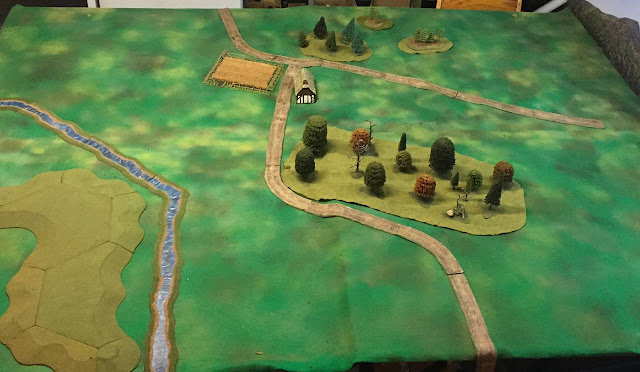Barry and I got together today for the third battle of our LANNES campaign, this one set in Autumn,1806.
Overview of Oritango Downs from the North, soon to be the scene of a fierce confrontation between the French troops of Francois Faucon and the Russians of Boris Badenov
View form the West, where the French will deploy.
View of Oritango Downs from the Russian Deployment areas (East).
And finally a view of the field from the South.

One of the four French Commands was delayed; unfortunately, this turned out to be one of my two large Infantry commands. Francois lost the toss and thus had to deploy one of his commands first - he chose the cavalry Brigade of Simeon Souris, better known for his lack of personal bravery than any military talent, and deployed it to the North of the Oritango Forrest. . Boris countered with a Russian Dragoon brigade deployed to their North as well. Fancois next deployed his infantry command, heavy with Light Infantry, opposite the woods, and Borris responded with an even larger infantry command of his own deployed across the woods from the. Francois placed his last command, a brigade of mixed cavalry supported by a Horse artillery battery, behind the Southern end of the Woods. His second Infantry command has orders to march with all haste for the gap between the river and the Oritango Forrest. Reports indicated that they would only be delayed about 2 hours; better than it could have been! Boris deployed his second infantry command opposite the river and hill, evidently having some idea of a grand outflanking move. They were supported by a lone Uhlan regiment under the order of General Scardikatsky.

View from behind the Russian lines at the start of the action.
View from behind the French center. Faucon, with a newly improved Leadership Die of D12 rolled up a Skilled Sequence Deck, whilst Badenov, fittingly, rolled Poor Deck, still having a D10 Leadership Die. Both rolled up 15 Army Morale Points for their forces.
Although the French started with the initiative, their first run of cards were all unusable. On the Russian side, though, their forces marched forward very smartly, the lead unit contacting the fringes of the Oritango Forrest.
The Southern wing of the Russian forces moved forwards with less self assurance.
Some long range Russian Artillery fire pushed the Chaumont Hussars back with losses.
Following a bold move into the Forrest by the Russian infantry, the French finally shook themselves out and into action. The refused their right flank cavalry and unlimbered a rather weak 6 lber foot battery to further help protect that flank, whilst dispatching the infantry of Henri Hibou's brigade to contest the woods. Consisting largely of light infantry, shots were exchanged all across the woods. Finally, the Infantry brigade of Rene Renard made a timely appearance to shore up the Southern end of the French position.

On the Northern half of the field, one of the French Light units in the woods pulled back voluntarily after suffering heavy (3 UI) losses. The French Artillery, having scored a lucky hit on the Russian Dragoons earlier, saw them shrug off their losses and charge home before the perspiring cannoneers could reload their pieces.
The outcome of such a contest was never in real doubt, and the French artillerists were sabered where they stood. That square is looking like a good idea (formed by a rather odd unit of DD10, CD8 Guardsmen!).
However, General de Brigade Renard lead his forces forward with aplomb, directing 2 units to cross the shallow liver and seize the Obertango heights.
The Russians are getting the better of the fire fight in the Forrest, and have driven back or routed all three of General Hibou's Light infantry units.
Seizing the moment, the Bordeaux Chasseurs launch a surprise charge on the Russian Dragoons, after fire from the Russian Horse battery fails to inflict significant damage upon them.
In a protracted fight, the Russian Dragoons are destroyed by the Chasseurs.
Meanwhile, the Russians evict the last of the French units from the Forrest; the French Center is looking very weak and vulnerable!
To take the pressure off the Center, Faucon Directs Renard's men to press forward, a unit of Young Guard in the lead. These troops will win the honors of the day, as they shrugged off both artillery and close range small arms fire, and then force back a Russian Musketeer battalion with their own fire. Although becoming somewhat isolated, they do have both Artillery and Cavalry support to their rear.
The second Russian Dragoon unit's attempt to ride down the Chasseurs comes to a bad end, routed with heavy losses.
As the dust from the fierce cavalry melee clears, General Souris is down! It seems that his uncharacteristic acts of bravery, which inspired the Chasseurs, have lead to him being hors de combat.
On the Southern end of the battlefield, the French infantry on the hill pepper the Russian Uhlans with successive volleys, emptying their saddles gradually. In a maneuver worthy of Senarmont himself, Renard's foot artillery press to within canister range of the Russians, but hold their fire.
The French return to contest the woods with some success, but a column attack by the Guards is repulsed with heavy losses, routing them!
With the Russian horse artillery standing unloaded. the Chaumont Hussars ride down the fugitives of the Russian Dragoons, thus being sure that they are out of action for the day. But what is this? It seems General Souris is back in the saddle after all. How is that possible? "A stroke of good fortune! The bullet was stopped by the encased portrait of my dear friend, Tomas, which I carry always in a pocket over my heart." This brings more than a few snickers and wisecracks from the ranks of his troopers,

Back on the Southern end of the Downs, the Young Guard continue to press forwards and fire, routing a Russian battalion. The fire of the French infantry on the hillside similarly routs the Uhlans, and a French infantry column inflicts heavy losses on a Russian battery. With their Morale severely drained, the Russians begin withdrawing. In view of their weak center and the overextended position of some of Renard's troops, General Faucon is content to let them depart without undue harassment. The battle of Oritango Downs is over! [At the end of the battle Faucon had 9 Morale Points left out of 15, whilst Badenov has been down to zero and thus paying them to the French for the past 2 (game) hours].
























































